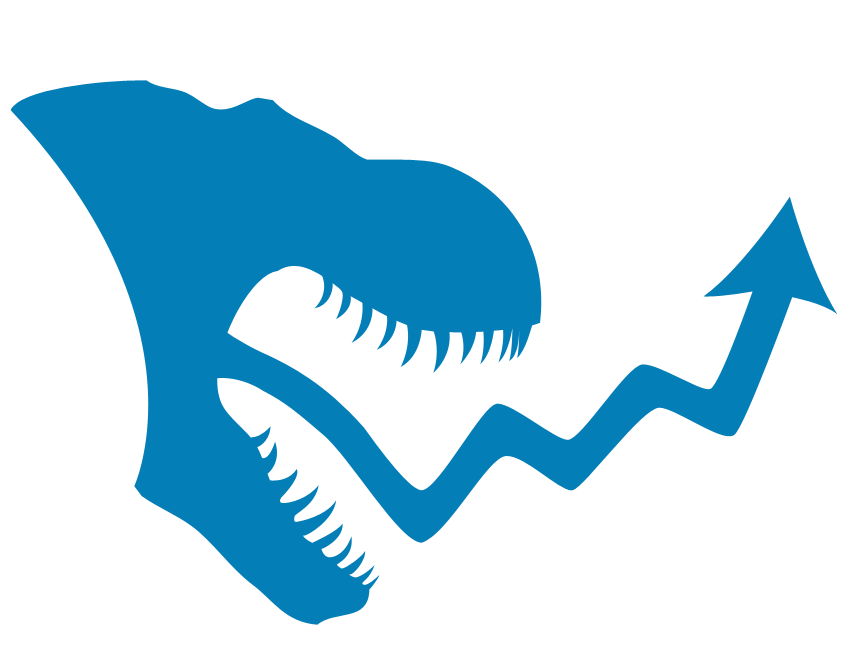Have you ever searched for a list of the best tools or guides on a topic and found a page that brings them all together in one place? That kind of page is called a resource page. Getting your website listed on one of those pages is known as resource page link building, and it’s one of the most effective ways to earn trusted backlinks.
These links are valuable because they come from reputable websites that both users and search engines already trust. They help improve your site’s credibility, authority, and search rankings in a natural and safe way.
Still, organic growth can take time. To speed up results, many SEO professionals use a hybrid strategy that combines resource page links with carefully managed PBN (Private Blog Network) links. When used wisely, this approach helps you rank faster while keeping your main site secure.
In this guide, you’ll learn what resource page link building is, how to build these links step by step, and when it makes sense to add PBN support to achieve faster and safer SEO growth.
What Is a Resource Page (and Why Google Loves It)
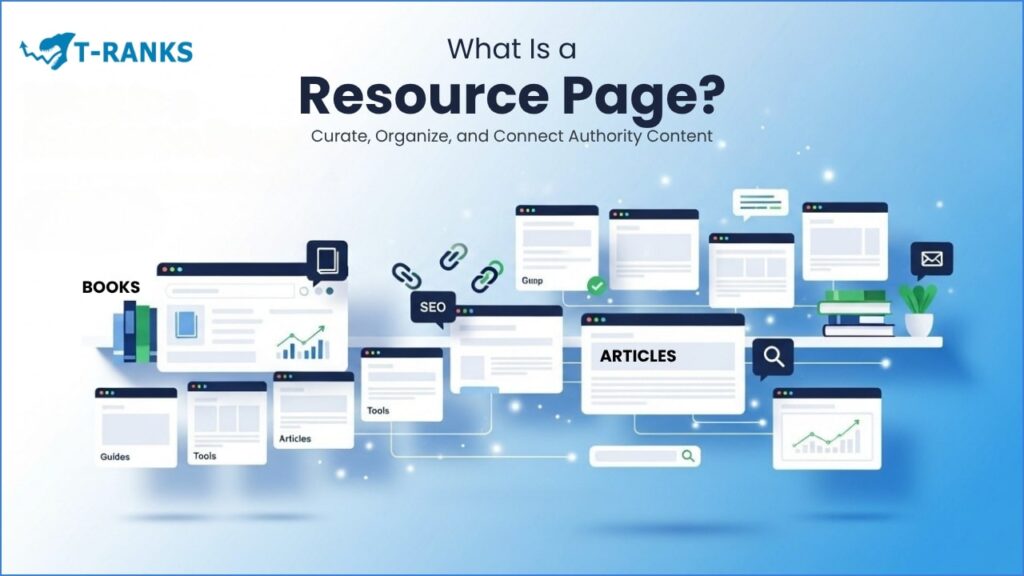
In SEO, a resource page is a webpage that curates the most useful links, guides, and tools about a specific topic. Its goal is to help visitors find the best, most trustworthy information without endless searching. These pages often act as link libraries within a niche, connecting readers to high-quality references that solve a specific problem or answer a question. Search engines value them because they organize and link to credible, relevant, and regularly updated content.
Let me explain it for you in this way to make it easy. Think of a resource page like a digital library or supermarket. In a library, all books on the same subject are placed on one shelf so readers can easily find what they need. In a supermarket, all shampoos are in one section so you can compare and choose the best one.
Similarly, a resource page gathers all the best articles, guides, and tools about one topic in one place, making it easier for both users and search engines to understand its relevance and authority.
Why Google Loves Resource Pages

- Showcases Expertise and Authority: They show that the website carefully curates reliable, high-quality information.
- Funnels PageRank Effectively: Outbound links are focused and selective, allowing more SEO value to flow to each linked page.
- Boosts E-E-A-T Signals: Being listed on an authoritative resource page acts as a trust endorsement in Google’s ranking system.
- User-Focused Experience: They help users save time by providing all verified sources in one place, aligning perfectly with Google’s helpful content and people-first guidelines.
Example
A good example is the “Useful Links” page created for students at a university writing center. It lists trusted educational resources such as English Grammar for You, Guide to Grammar and Writing, and Merriam-Webster Dictionary and Thesaurus. Each link leads to a credible site that improves writing, grammar, or vocabulary. This kind of page acts like a mini knowledge hub, connecting students to verified learning tools in a single, easy-to-navigate location.
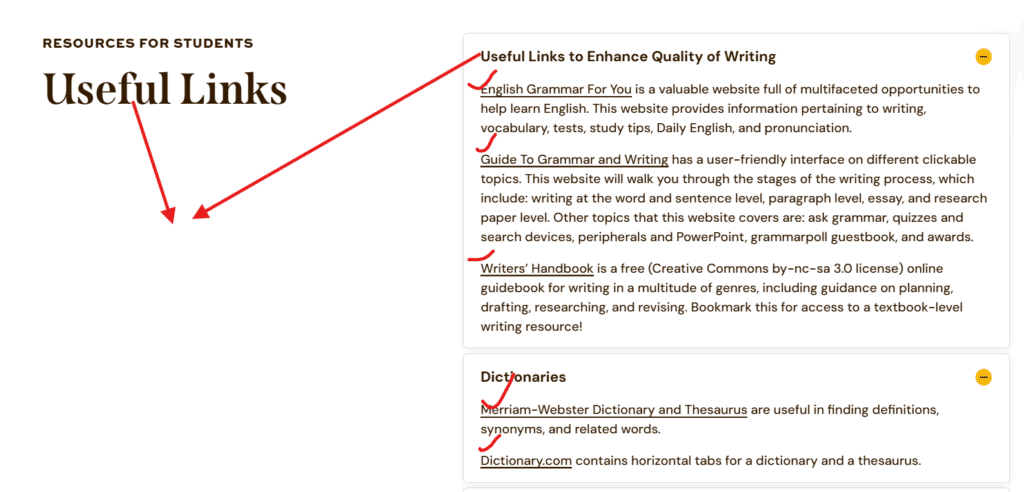
Why Resource Page Links Are More Powerful Than Guest Posts in 2026

In 2026, not every backlink carries the same weight. Resource page links often perform better than regular guest posts because they are more trusted, relevant, and long-lasting. These links help your website rank higher on Google and even show up more often in AI-powered search engines and tools like ChatGPT, Perplexity, and Grok, which prefer reliable and topic-focused sources.
Let’s break down why resource page links are so effective.
1. More Relevant to the Topic
Resource page links come from pages built around a clear theme or niche.
For example, if your SEO guide appears on a “Best SEO Tools” resource page, it sends a strong relevance signal to Google. That single placement is more valuable than a random guest post on a broad marketing blog. Search engines and AI tools recognize this context and often refer back to such pages when generating results or summaries.
2. Gain Extra Backlinks Over Time
Resource pages often become reference hubs for other content creators.
Writers, students, and journalists use them as reliable sources and may link back to them in their own content. This means your website can earn new backlinks naturally over time, even without extra outreach. Guest posts rarely create this ripple effect once published.
3. Stay Active for Years
Guest posts can disappear or lose visibility as new articles get added.
Resource pages, on the other hand, are evergreen. They stay live for years, keep attracting traffic, and continue passing link authority to your site. One strong resource page link can often bring more lasting results than several short-lived guest posts.
4. Safe and Google-Friendly
Resource page links are earned through useful content, not through payments or link exchanges.
This makes them much safer during algorithm updates. Guest posts, especially sponsored or low-quality ones, can lose value or even become risky over time. Resource pages stay compliant because they exist to help users, not manipulate rankings.
5. High Authority and Trust
Most resource pages are found on respected domains such as .edu, .org, or well-known industry sites.
These pages usually have fewer outbound links, which means your site receives stronger authority from each placement. A single link from a trusted source can be worth more than several links from blogs that publish too many guest posts.
6. Proven Long-Term Results
Data from tools like Ahrefs and Backlinko shows that resource page links
- Have higher acceptance rates in outreach campaigns
- Bring more referral visitors
- Stay live much longer than guest posts
In short
A single resource page link can bring more lasting SEO value than multiple generic guest posts. Unless you’re publishing on a top-tier editorial website, resource page link building is a safer, more reliable, and more sustainable way to build authority .Especially now, when AI-driven search rewards credible and contextually relevant sources.
When to Combine Resource Page Links with PBNs for Faster Results
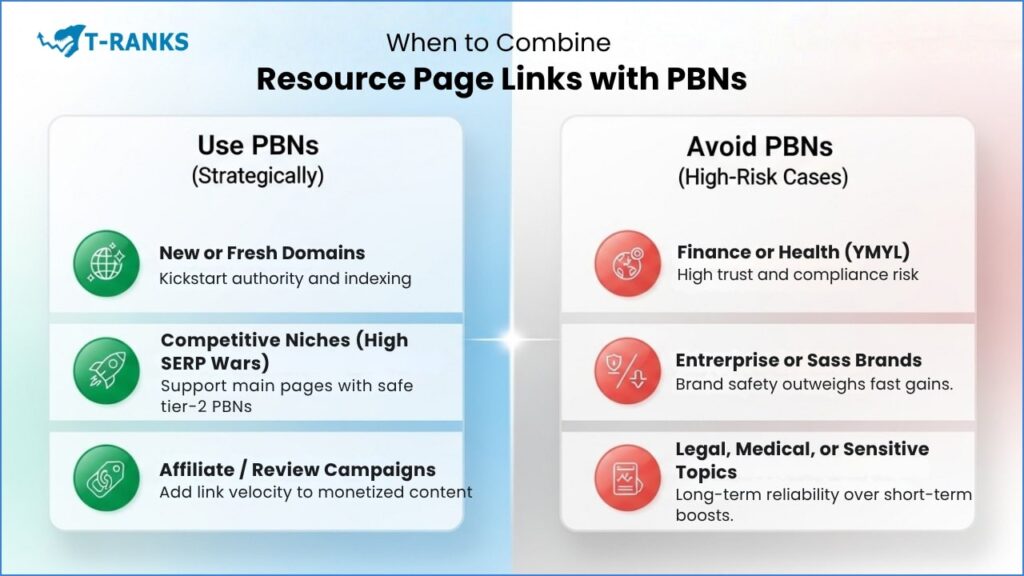
Resource page link building creates a strong foundation of authority and trust, but it can take time to show visible ranking results. That’s where a carefully controlled layer of PBN links can help. If done correctly, this combination accelerates your progress while keeping your main site safe.
Think of it like adding a turbo boost to a car that already has a powerful engine. Your earned resource page links are the engine that drives long-term credibility. PBN links, when built responsibly from trusted networks such as T-RANKS’ managed domains. It give your campaign short bursts of speed by strengthening those earned links at the Tier 2 level.
However, not every situation calls for PBN support. In some niches, even a small mistake can attract risk or manual penalties. The goal is to use PBNs strategically as a supporting layer, never as the main source of authority.
The following table shows when a PBN layer might help and when it is better to rely only on resource page links.
| Scenario | Speed Urgency | Risk Level | Budget | Recommended PBN Use | Notes |
| New Domain (less than 6 months) | High | Medium | Limited | Small Tier 2 PBN links to resource pages only | Helps amplify early resource links safely. Avoid direct links to your main site. |
| YMYL / Health / Finance Niches | Medium | Very High | High | Not recommended | These industries depend heavily on Google’s trust signals. Stick to earned, white-hat links only. |
| Highly Competitive SERPs (KD above 60) | High | Medium | High | 5–8 Tier 2 PBN links after securing 3–5 earned links | Safely adds extra authority without linking directly to money pages. |
| Local or Long-Tail Niches | Medium | Medium | Moderate | 2–3 PBN links once an earned link exists | Gives a slight visibility boost for slower-moving local keywords. |
| Affiliate or Seasonal Campaigns | High | High | Moderate | 1–2 PBN links per week with careful monitoring | Works for short-term ranking bursts. Remove links if flagged. |
| Enterprise or Brand-Sensitive Sites | Low | Very High | High | Not recommended | Reputation matters more than speed. Rely only on natural and editorial links. |
Key Takeaways
- Always secure at least 3–5 earned resource page links before considering any PBNs.
- Never point PBN links directly to your money pages. Use them only to strengthen Tier 1 resource links.
- Assess your niche risk carefully. In sensitive fields like health or finance, skip PBNs entirely.
- Treat PBNs as a temporary performance booster, not a core SEO strategy.
- When sourced from trusted and managed PBN networks like T-RANKS, you can achieve faster results while keeping risk low.
In short: Combining resource page links with well-managed PBNs is an advanced but effective approach when applied strategically. It helps you achieve both stability and speed , the stability comes from your earned authority, and the speed comes from carefully layered support links. This keeps your SEO growth natural and sustainable.
Step-by-Step Guide: Building Resource Page Links
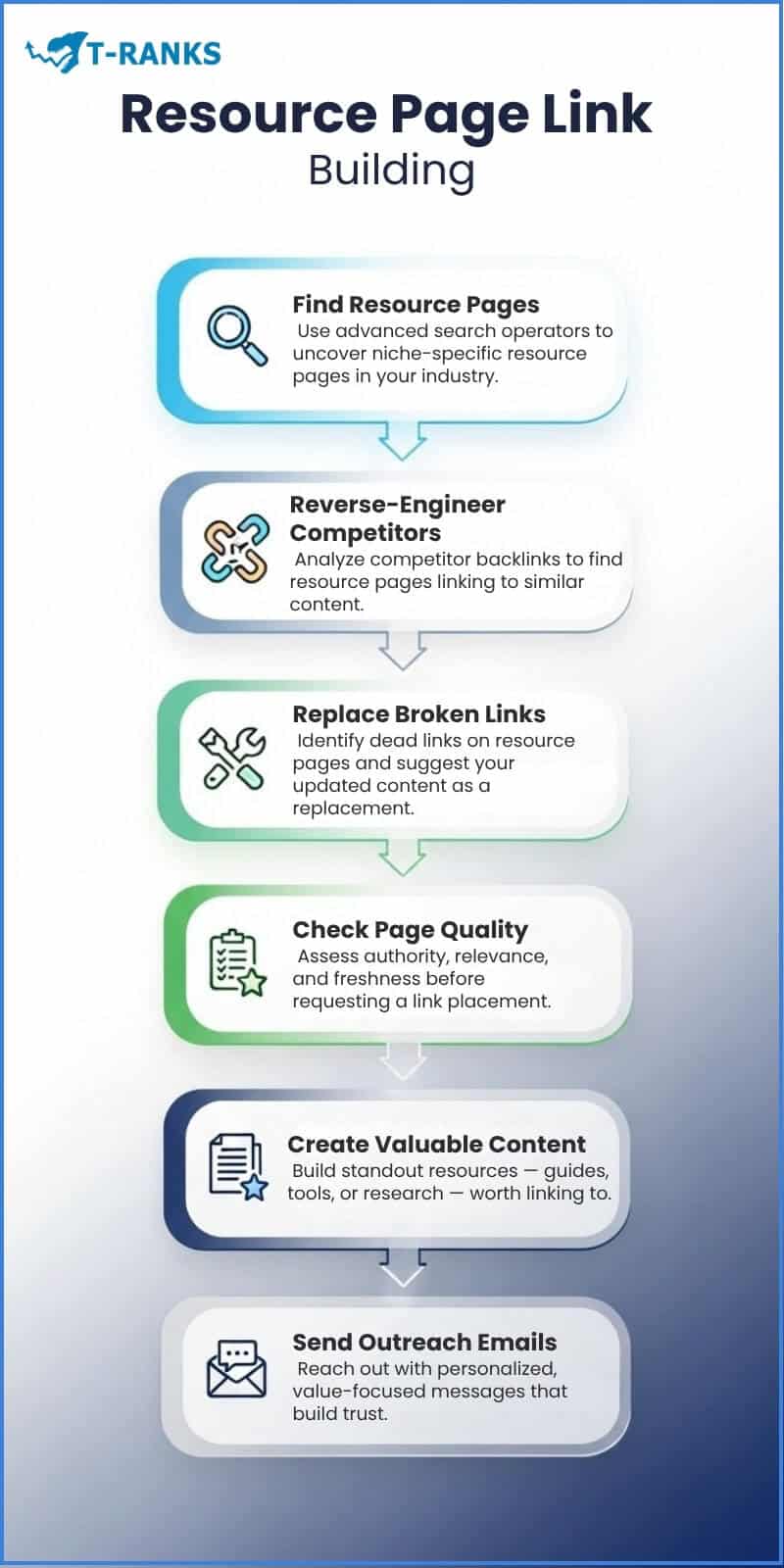
Resource page link building is a smart, white-hat SEO strategy where you get backlinks from pages that list helpful links in your niche. These pages are trusted by Google, drive referral traffic, and improve your SEO. Now, we’ll discuss how to find these pages, qualify them, create valuable resources, and reach out effectively.
1. Find Resource Pages Using Google Search
The first step is locating pages that already list useful resources. Google search operators help you find them quickly.
Examples:
“SEO tools” intitle:resources
“Email marketing” inurl:useful-links
“Content marketing” intitle:”helpful resources”
site:.edu “link directory”
Here are the type of resource page you will see when you will search the above first one in title search operator.

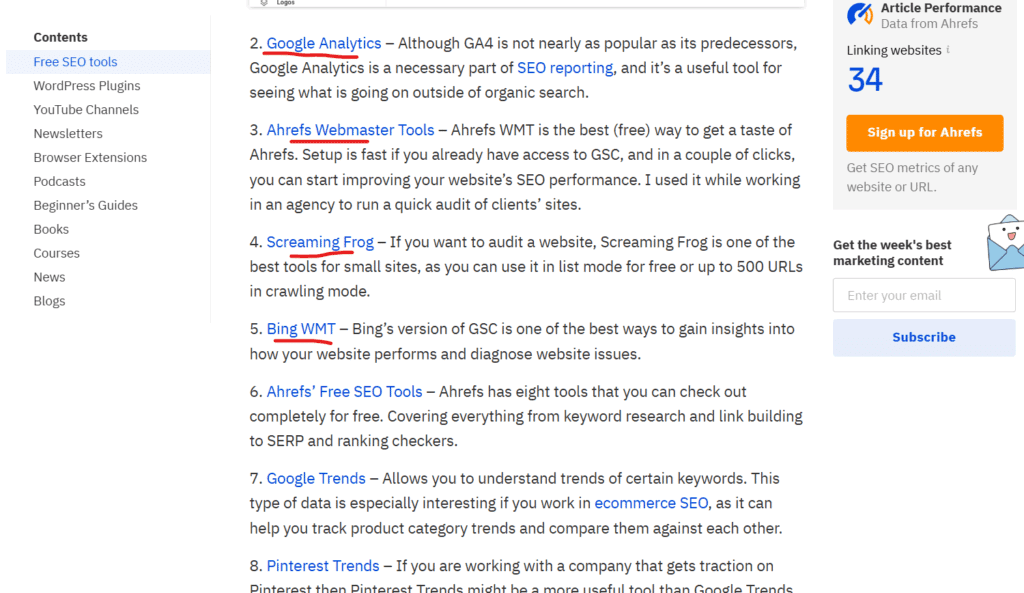
Tip: Add -blog or -affiliate to exclude low-quality pages. Focus on DA 30+ pages that are topically relevant.
Checklist:
| Action | Key Tips | Example |
| Use Google search operators to locate relevant pages. | Use intitle:resources, inurl:useful-links, and DA 30+ filter. | “SEO tools” intitle:resources site:.edu |
2. Reverse-Engineer Competitors’ Resource Links
Check which resource pages already link to your competitors. If they link to similar content, there’s a good chance they’ll accept yours too.
How to do it:
- Use Ahrefs, Semrush, or Moz.
- Enter a competitor’s domain → Backlinks → Filter for pages containing “resources” or “links.”
- Export URLs to a list.
Example:You type “Search Engine Journal” then you click on backlinks check resource pages and you can then pitch too.

Checklist:
| Action | Key Tips | Example |
| Check which resource pages link to competitors. | Ahrefs/Semrush → Backlinks → Filter “resources” → Export URLs. | Competitor’s “SEO Tools Guide” linked on “SEO Resources for Marketers” |
3. Find Broken Links You Can Replace
Many resource pages have dead or outdated links. Spotting these is a quick win. Offer your content as a replacement it helps the page owner and gets you a high-quality backlink.
Tools: Check My Links (Chrome extension), Broken Link Checker
Example: A resource page links to an old 404 guide on “Email Segmentation.” You can pitch your updated 2025 guide as a replacement.
Checklist:
| Action | Key Tips | Example |
| Identify dead or outdated links on pages. | Use Check My Links or Broken Link Checker. Offer your content as replacement. | A 404 link to “Email Segmentation Guide 2022” → pitch your updated 2025 guide |
4. Check Page Quality Before Outreach
Not every resource page is worth your effort. Evaluate pages before reaching out:
- Authority: DR 30+
- Relevance: Topic matches your content
- Outbound links: <100 total, ideally <50
- Page activity: Updated in last 12 months
Example: A page with 200 outbound links and low relevance is less valuable than a niche-focused, high-authority page with 30 links.
Checklist:
| Action | Key Tips | Example |
| Check authority, relevance, outbound links, and page activity. | DR 30+, relevant topic, <100 outbound links, updated within 12 months. | A niche page with 30 links and updated last month is high-value |
5. Create a Valuable Resource People Want to Link
You need content that is useful, unique, and better than existing resources.
Types of link-worthy content:
- Comprehensive guides: 2,000–5,000 words
- Infographics: Visual summary of complex info
- Tools or templates: Checklists, calculators, ROI estimators
- Original research: Surveys or industry studies
Example: If pitching a page about “SEO Tools,” create a downloadable PDF checklist of 50+ tools with pros, cons, and setup instructions.
Checklist:
| Action | Key Tips | Example |
| Build content people want to link to. | Guides, infographics, tools, templates, or original research. Make it unique and practical. | Downloadable checklist of 50+ SEO tools with pros/cons |
6. Send Personalized Outreach Emails
Generic emails get ignored. Personalization outreach shows you’ve researched the page and genuinely provide value. Mention specifics and explain why your resource fits.
Template Example:
Subject: A Suggestion for Your [Resource Page Name]
Hi [Webmaster Name],
I enjoyed your [Resource Page Name] guide—it’s very helpful. I noticed you link to [Competitor Resource]. I recently published a [guide/tool/infographic] on [Your Topic], which could add value for your readers: [Your URL].
Best,
[Your Name]
Tip: For broken links, start by pointing out the dead link, then suggest your resource as a replacement. Acceptance rates are higher because you’re solving a problem.
Pro Tip: Keep a spreadsheet to track each page — URL, DA, outbound links, relevance, contact info, and outreach status. This keeps your campaign organized and increases success.
Checklist:
| Action | Key Tips | Example |
| Send tailored emails showing you’ve researched the page. | Mention specifics, add value first, low-pressure CTA. For broken links, start by pointing out the dead link. | Email: “I noticed a broken link to [Old Guide], here’s our updated guide: [URL]” |
How to Use This Merged Guide & Checklist:
- Start from Step 1 and follow both the instructions and checklist side by side.
- Score pages using Step 4 criteria before outreach.
- Track everything in a spreadsheet: URL, DA, relevance, contact, and outreach status.
- Follow up politely if no response after 1–2 weeks.
How to Create “Link-Magnets” That Win Resource Placements
A link-magnet is content so useful and valuable that other websites naturally want to link to it. Think of it like a magnet that attracts links. Resource pages love linking to content that helps their audience.
Here’s how to make content that gets featured:
1. Fill a Content Gap
Look for topics that aren’t fully covered yet.
- Check resource pages for outdated, incomplete, or weak content.
- Use keyword research to find popular topics with few high-quality guides.
Example: A resource page links to a 2022 “SEO Tools List.” You create a 2025 updated list with all new tools.
2. Make Comprehensive Guides
Create long, detailed guides that explain everything about a topic.
- Use headings, bullet points, charts, and expert tips.
- Make it easy for readers to scan and understand.
Example: “Complete Guide to Email Marketing Metrics” with step-by-step instructions and visuals.
3. Publish Original Research
Collect unique data through surveys, studies, or industry analysis.
- Resource pages love citing fresh, credible research.
Example: “500 Marketers Share Email Automation ROI” with charts and key insights.
4. Build Interactive Tools or Templates
Tools and templates solve real problems instantly.
- Calculators, planners, or quizzes are highly shareable.
Example: A free “Anchor-Text Generator” or “Content ROI Calculator.”
5. Focus on User Experience
Even the best content won’t earn links if it’s hard to read.
- Make it mobile-friendly, fast-loading, and easy to navigate.
- Use clear headings, bullet points, bold key points, and downloadable assets.
Example: A guide with checklists, interactive charts, and clear headings.
6. Make It Easy to Link
Ensure your content can be easily shared or embedded.
- Include visuals, infographics, PDFs, or tables.
- Add clear instructions or embed codes for resource pages.
Example: A downloadable checklist or infographic that other sites can directly use.
✅ In short:
A link-magnet is content that helps readers, answers questions, or solves problems so well that other websites naturally link to it. The more useful, clear, and easy-to-use your content is, the higher the chance it gets featured on resource pages.
Tier-2 Boost: Pointing Links at Your Resource Page (Safe Approach)
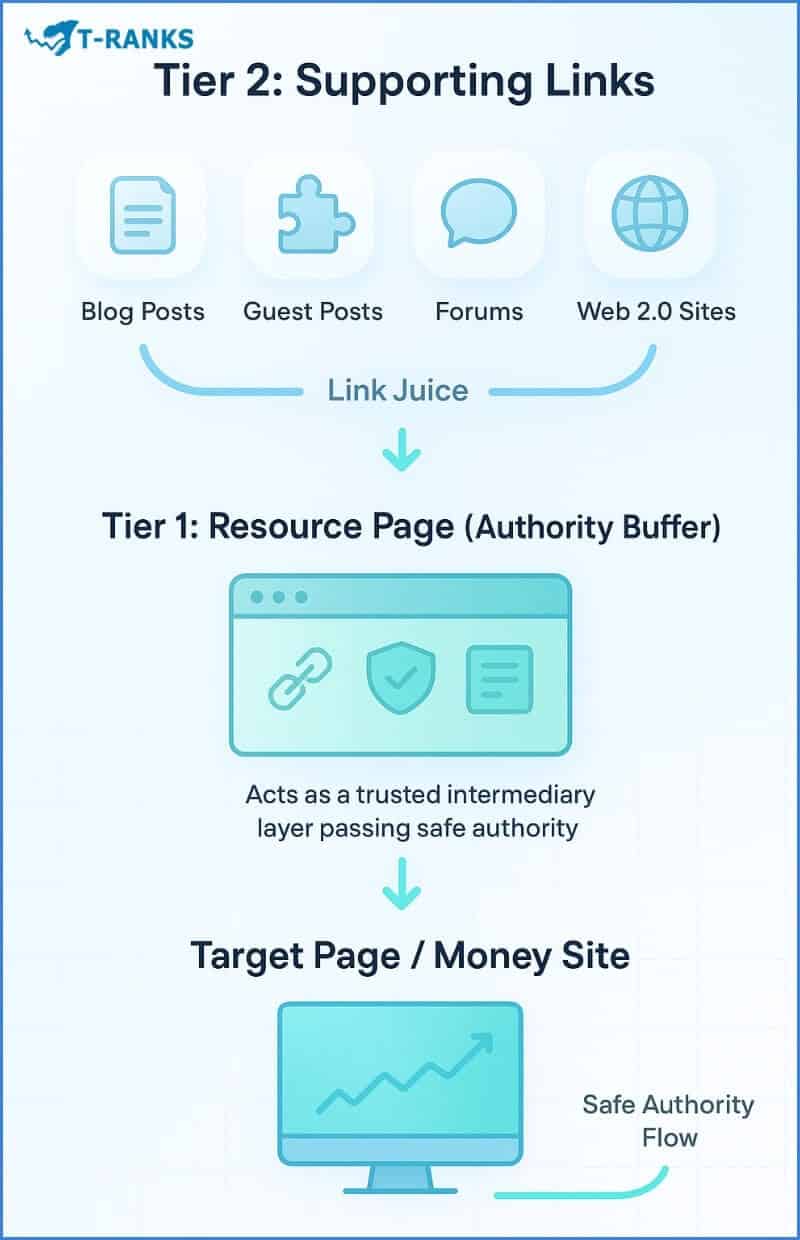
Once you have created high-value resource pages, you can increase their authority and ranking potential using a Tier-2 linking strategy. In this approach, additional links point to your resource pages instead of your main product or service pages. This helps your content gain authority safely, which then passes naturally to your main pages through internal linking.
Why Tier-2 Linking is Important
- Strengthens Resource Pages: Additional high-quality links improve the authority of your resource page.
- Supports Main Content: Resource pages act as hubs, passing link equity to your core content without direct manipulative links.
- Safe for SEO: Using white-hat sources avoids penalties while still boosting rankings.
Choosing Safe Tier-2 Link Sources
Focus on legitimate, high-quality sources to safely boost your resource pages:
- Authoritative blogs or industry websites
- Guest posts with relevant content
- Social media posts and shares
- Forums, Q&A sites, and community platforms
- Web 2.0 properties like Medium, Substack, or niche blogs
Avoid risky tactics such as PBNs, link farms, or automated link building.
How to Use Anchor Text for Tier-2 Links
Anchor text should look natural to Google while providing relevance to your resource page.
| Anchor Type | Recommended Use | Example | Why It Works |
| Branded | 50–60% | “YourBrand Guide” | Appears natural and trustworthy |
| Naked URL | 15–20% | “https://yoursite.com/resources” | Neutral and safe |
| Generic | 10–15% | “Click here,” “Learn more” | Adds variety and low risk |
| Partial Match | 10–15% | “SEO resource guide,” “Marketing tips collection” | Adds relevance without over-optimization |
| Exact Match | 0–5% | Use very rarely | High risk if overused |
Tips:
- Vary anchor phrases across links.
- Most links should be branded, generic, or URL-based.
- Use partial match anchors to add topical relevance naturally.
Scheduling Tier-2 Links
Add links gradually to appear natural. Sudden spikes can signal manipulation to search engines.
| Website Age | Links per Week | Strategy |
| New (<3 months) | 1–2 | Start slow to avoid suspicion |
| Established (1–2 years) | 3–5 | Spread links across the week |
| Authority (3+ years) | 5–10 | Gradually increase volume safely |
Practical Tips:
- Spread links over multiple days (e.g., Monday, Wednesday, Friday).
- Track each link: date, source, anchor text, target URL.
- Monitor Google Search Console for indexing and performance changes.
- Adjust link building pace if you notice drops or updates.
Example 4-Week Safe Tier-2 Schedule:
- Week 1: Branded anchor, Naked URL
- Week 2: Generic anchor, Partial match
- Week 3: Branded anchor, review results
- Week 4: Naked URL, plan for next month
Tracking Success: KPIs & Tools

So, you’ve built your resource page and even boosted it with some safe Tier-2 links. Great! But how do you know if all this effort is actually paying off? That’s where tracking the right KPIs (Key Performance Indicators) comes in. These metrics help you understand whether your strategy is working, show real business impact, and give you insights for improvement.
Let’s break it down step by step.
1. Organic Clicks to Your Resource Page
The first thing you want to track is how many people are actually visiting your resource page from Google.
- Why it matters: This is your most important metric because it shows real user engagement. More clicks mean your page is visible, helpful, and relevant.
- How to track: Use Google Search Console (GSC) → Performance → Filter by your resource page URL.
- Tip: Focus on clicks rather than just impressions. A page may be seen by many, but clicks show genuine interest.
2. New Referring Domains
Next, keep an eye on the number of unique websites linking to your resource page.
- Why it matters: More high-quality referring domains boost your authority and signal to Google that your content is trustworthy.
- How to track: Use Ahrefs → Site Explorer → Referring Domains report.
- Tip: Aim for consistent growth each month. Sudden spikes may look unnatural.
3. Domain Authority / Rating
It’s not just about the number of links, but also the quality.
- Why it matters: Links from strong, authoritative websites carry more weight. They help your page rank higher and improve your overall domain authority.
- How to track: Check Ahrefs DR or Moz DA.
- Tip: Prioritize building links from domains with higher authority rather than chasing quantity.
4. Anchor Text Distribution
Anchor text is the clickable text used in links. Tracking it ensures your links look natural.
- Why it matters: Too many exact-match anchors can trigger penalties. A healthy mix (branded, generic, URL, partial match) keeps your profile safe.
- How to track: Use Ahrefs or Moz to monitor anchor text diversity.
5. Referral Traffic from Resource Pages
It’s one thing to have links, but are they sending visitors to your site?
- Why it matters: Referral traffic shows that your resource page links are actually engaging users who may convert.
- How to track: GA4 → Acquisition → Referrals filtered by resource page URLs.
- Tip: Track engagement and micro-conversions (like newsletter signups or downloads) to measure real value.
6. AI & Generative Search Citations
Here’s something newer: your resource pages may be cited in AI tools like Perplexity, Surfer AI, or ChatGPT search results.
- Why it matters: AI citations act as a new form of authority. If your content is frequently referenced, it signals trustworthiness to both AI and human users.
- How to track: Use Perplexity watchlists, Surfer AI Tracker, or similar AI citation tools.
Tools You’ll Need
To make tracking easier and accurate, use these platforms:
- Google Search Console: Track clicks, impressions, CTR, and keyword performance.
- Ahrefs / Moz: Monitor referring domains, DR, backlink quality, and anchor text diversity.
- Google Analytics 4 (GA4): Track referral traffic, user engagement, and conversions.
- Perplexity / AI Citation Trackers: Monitor emerging visibility in AI-generated results.
Troubleshooting: 5 Reasons Outreach Fails & How to Fix Them

Outreach campaigns can sometimes feel frustrating. You send emails, but hardly anyone responds. If your resource page link-building isn’t getting results, it’s usually due to a few common issues. Here’s a simple guide to what goes wrong and how to fix it.
1. Target Mismatch
Problem: You’re pitching to the wrong page or audience. Your content might be too broad, too niche, or not useful for their readers.
Solution:
- Research the page thoroughly. Check the topics they cover and the links they already have.
- Only reach out if your content clearly improves their page.
- Set a relevance standard: aim for at least 7/10 match before contacting.
2. Thin or Weak Content
Problem: Your resource isn’t strong enough to stand out. Editors skip links that don’t add value.
Solution:
- Add more depth: include charts, infographics, examples, or interactive tools.
- Compare your resource to the top 3 linked pages on that site.
- Make your content clearly the “best-in-section.”
3. Emails Land in Spam or Get Ignored
Problem: Your outreach emails never reach the inbox or get lost among hundreds of other pitches.
Solution:
- Send from a professional domain-based email, not Gmail/Yahoo.
- Personalize every email. Mention their specific page, article, or project.
- Warm up your email account gradually.
- Test subject lines and schedule polite follow-ups 5–7 days apart.
4. Poor or No Follow-Up
Problem: You send one email and move on. Most responses come after a second or third email.
Solution:
- Use a 3-step follow-up sequence:
- Original email
- Reminder after 5–7 days
- Final “checking in” email after 10–14 days with optional social proof (e.g., “We were recently featured on [other resource page]”).
- Original email
- Keep follow-ups short, helpful, and friendly.
5. Timing Issues
Problem: Emails arrive when the recipient is busy, distracted, or away.
Solution:
- Send emails mid-week, in the morning, using their time zone.
- If open rates are low, try rescheduling outreach for a different week or after major events.
Key Takeaway:
Successful outreach isn’t just about sending emails. It’s about finding the right target, offering real value, crafting strong content, timing it properly, and following up consistently. Fix these issues, and your chances of getting valuable backlinks increase dramatically.
Conclusion
In conclusion, combining resource page link building with controlled Tier-2 PBN support creates a powerful hybrid strategy that delivers both speed and sustainability. Earned resource page links build long-term authority, trust, and referral traffic, while Tier-2 links amplify these placements safely, accelerating rankings without exposing your main site to risk. By monitoring KPIs, optimizing outreach, and maintaining disciplined link velocity, this approach ensures measurable growth, higher visibility, and improved organic performance.
Pro Tip: Take action now and let T-RANKS help you design and execute a hybrid link-building campaign that boosts your authority, rankings, and traffic with precision and safety.
FAQs Of Resource Page Link Building
How many resource page links do I need before adding PBNs?
Aim for 5–7 earned links first, then layer 3–5 branded PBN links for acceleration.
Starting with earned links establishes trust and reduces risk. PBNs should only amplify a resource page once initial credibility is in place.
Do PBN links to a resource page carry the same risk?
No, they carry lower risk than linking directly to a money page, but maintaining footprint diversity and branded anchors is essential.
Using resource pages as a buffer absorbs most PBN risk while still passing authority effectively.
How do I find resource pages without paid tools?
Use Google operators like inurl:resources + “your topic” and free extensions such as Detailed SEO.
This approach helps locate high-relevance pages quickly without subscription costs.
Should I pay for placement on a resource page?
Avoid outright payments; instead, offer updated content or broken-link fixes.
Providing value keeps your outreach white-hat and more likely to succeed.
What response rate is normal for resource outreach?
A 5–10% response rate is typical when emails are personalized and followed up twice.
Consistency and relevance in messaging significantly improve placement chances.
Can I reuse the same asset for multiple niches?
Yes, but you should customize statistics and examples per niche to maintain relevance.
Generic content may get rejected or ignored; tailored assets increase acceptance rates.
How long does it take for resource page links to impact rankings?
Typically 3–6 months for earned links, with Tier-2 PBNs providing faster lifts in 2–4 weeks.
Link velocity and content quality directly influence how quickly ranking improvements appear.
Can Google detect PBNs pointing to resource pages?
Detection risk is low if Tier-2 links use clean domains, branded anchors, and staggered schedules.
The resource page acts as a buffer, making direct link patterns to money pages less obvious.
Is it better to focus on niche-specific or general resource pages?
Niche-specific pages are always more effective for relevance and link value.
General pages may drive some traffic, but targeted placements boost SEO and conversions.
Which anchor text types work best for Tier-2 links?
Branded, naked URLs, and generic anchors are safest; partial matches can be used sparingly.
Over-optimized exact-match anchors increase footprint risk and can trigger penalties.

